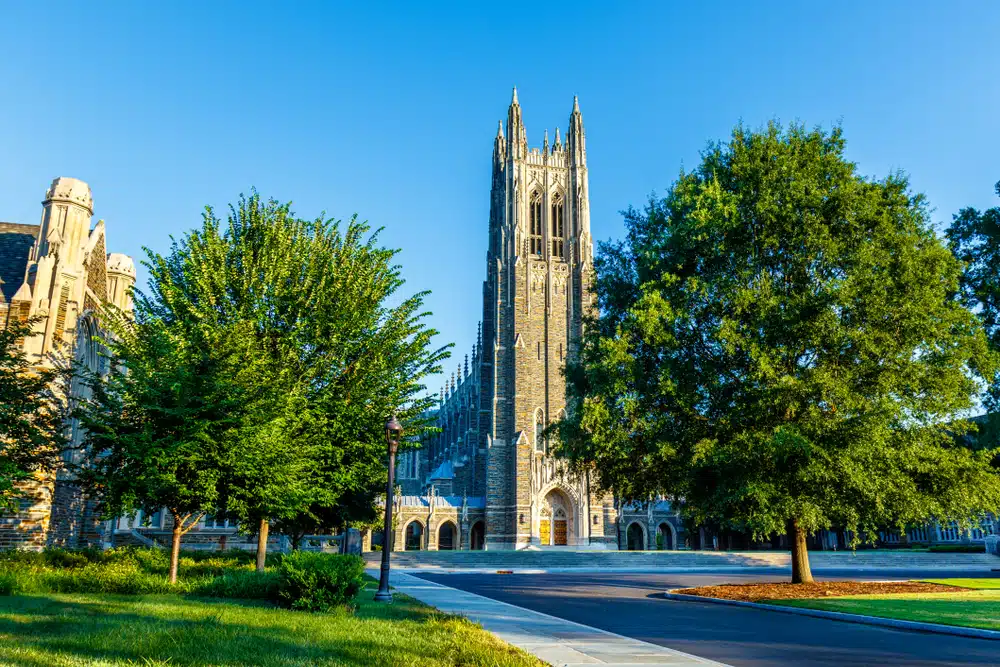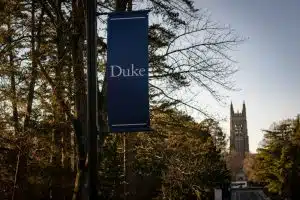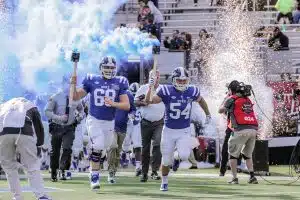Duke University’s Official Mascot
Today, we will learn more about the Blue Devil, the official mascot of Duke University. We will also talk about the multiple ways in which Blue Devil has contributed to the flourishing culture of sports at Duke.
In addition to that, we’ll also talk about Duke fun facts, such as the official colors of the school, which may be of interest to you.
Let’s meet the Blue Devil
At sporting events hosted by Duke University, the Blue Devil chants and leads the audience in cheers. The Duke Football Employee Kickoff Celebration is often held at Wallace Wade Stadium.
The Blue Devil, whose identity is never revealed in order to protect the team’s reputation, is the one who leads the football squad into the stadium, where he stays hydrated by drinking a lot of water and waves the battle flag after touchdowns.
Drawings of the first Blue Devil French soldier were used to create the mascot, but by the 1930s it had been updated to include a jumpsuit with long sleeves, and by the 1970s it had been given a cape and a mask in the style of Batman.
In 1992, when Lisa Weistart was a senior in English at Duke, she played the role of Blue Devil. Her responsibilities included donning the enormous cartoon head, dancing with cheerleaders, and destroying dolls.
In 2008, the polished head and conspicuous horns made their debut at the August football game against James Madison University, which marked the transition from the cartoon version of the Blue Devil mascot to the present design of the mascot, which was introduced in 2008.
What is the story behind Blue Devil?
The Chasseurs Alpins were well-known French soldiers who served during World War I. They were given the nickname “Les Diables Bleus.”
They first came to the public’s attention when their specialized training and localized expertise in the Alps were called upon to break the deadlock of trench warfare in their home territory of the French Alps.
The precursor of Duke’s official mascot is in fact, Duke’s official sports name; and there were a lot of nominations, including Catamounts, Grizzlies, Badgers, Dreadnaughts, and Captains, which was named in honor of the well-liked coach W. W. “Cap” Card.
The editors of the school newspaper recommended selecting a team name from among Blue Titans, Blue Eagles, Polar Bears, Blue Devils, Royal Blazes, or Blue Warriors because they believed that a name that incorporated the school’s colors of dark blue and white would be a suitable choice.
None of the nominations received a great deal of support, but Blue Devils seemed to have a sufficient amount of it to elicit the criticism that it would incite opposition on the Methodist campus “for obvious reasons,” and that it might prove risky and put football in jeopardy if a controversial name were to be used at that particular time. None of the nominations were chosen. The football season came and went without an official name being chosen for the team.
Since the expected results of democratic nomination and voting had not been achieved, the campus leaders from the Class of 1923 came to the conclusion that they needed to choose a name in order to move forward with their senior-year planning.
The editors of two of the other student journals, The Archive, and The Chanticleer, came to the conclusion that the staff of the student newspaper should adopt a name and “put it over.”
Therefore, at the beginning of the academic year 1922-1923, William H. Lander, in his capacity as editor-in-chief of the Trinity Chronicle, and Mike Bradshaw, in his capacity as managing editor, referred to the athletic teams as the Blue Devils.
Because the majority of the student body was comprised of returning soldiers at the time, there was no real need to provide a justification for the class’s moniker.
How Has the Blue Devil Evolved Over Time?
The evolution of Duke University’s official mascot, the Blue Devil, is a fascinating journey that mirrors the growth and transformation of Duke University itself. From its inception in the early 1920s, the Blue Devil has undergone significant changes, reflecting shifts in cultural attitudes, artistic trends, and the university’s own identity.
Initially, the Blue Devil was portrayed with a more sinister appearance, a reflection of its origins in French folklore. Over time, the figure has become more approachable and friendly, embodying the spirit of camaraderie and excellence that Duke strives to foster.
Changes in appearance and costume
The changes in appearance and costume of the mascot have been both subtle and dramatic. In the early days, the Blue Devil was depicted with sharp features and a somewhat menacing look.
Gradually, the costume was redesigned to be more inviting, with softer lines and a more cheerful expression. The color palette has also evolved, with variations in shades of blue to match the university’s official colors.
Modern iterations of the costume include high-tech materials that allow for greater mobility and comfort for the person inside the suit. These changes in appearance and costume are not merely superficial; they represent a conscious effort to align the mascot with the values and aspirations of the university and its students.
The Blue Devil’s role in various university events
Blue Devil plays a central role in various university events, from athletic games to community gatherings. Its presence at basketball games, for instance, is a beloved tradition that energizes fans and players alike.
But the Blue Devil’s role extends beyond sports. It appears at orientation events to welcome new students, at alumni gatherings to foster a sense of continuity, and at community outreach programs to symbolize Duke’s commitment to service.
The Blue Devil’s versatility and adaptability in various contexts underscore its importance as a unifying symbol that transcends mere entertainment. It’s a living embodiment of Duke’s spirit, bridging the gap between academics, athletics, and community engagement.
The mascot’s impact on Duke’s branding and marketing
The impact of Blue Devil on Duke’s branding and marketing cannot be overstated. The Blue Devil is not just a mascot; it’s a brand ambassador that conveys the essence of Duke University to the world.
Its image appears on merchandise, advertising materials, and even the university’s official website. The mascot’s unique blend of tradition and modernity resonates with a wide audience, from prospective students to loyal alumni.
By consistently integrating the Blue Devil into its branding and marketing efforts, Duke has created a recognizable and powerful symbol that encapsulates its values, ambitions, and unique identity.
How Does the Blue Devil Reflect Duke’s Spirit and Values?
Duke University’s official mascot, the Blue Devil, is more than a mere symbol; it’s a reflection of Duke’s spirit and values. The mascot’s energetic presence and charismatic charm embody the university’s commitment to excellence, innovation, and community.
Whether cheering on the athletic teams or engaging with students during campus events, the Blue Devil represents the drive, determination, and camaraderie that defines the Duke experience. Its evolution over time, adapting to cultural shifts and embracing modernity, mirrors Duke’s own journey towards growth and transformation.
The symbolism of the Blue Devil
The symbolism of the Blue Devil as the Duke’s Official Mascot is rich and multifaceted. Its origins in French folklore and connection to a historic military unit speak to a legacy of courage and resilience.
The color blue, synonymous with Duke, represents wisdom, confidence, and integrity. The devil imagery, while playful, conveys a sense of fierce competitiveness and determination. Together, these elements create a symbol that is both unique and deeply resonant with Duke’s identity.
The Blue Devil is not just a mascot; it’s a symbol that encapsulates the essence of Duke University, reflecting its history, its values, and its aspirations.
Connection to Duke’s athletic teams
The connection between the mascot and Duke’s athletic teams is profound and enduring. The Blue Devil is a fixture at games, where its energetic antics and spirited cheerleading galvanize fans and athletes alike.
But beyond the spectacle, the mascot represents the spirit of sportsmanship, teamwork, and excellence that defines Duke’s athletic culture. Whether it’s a high-stakes basketball game or a friendly intramural match, the presence of the Blue Devil reinforces the sense of pride and unity that binds Duke’s athletes and supporters.
The Blue Devil- a unifying symbol for students and alumni
Duke University’s official mascot serves as a unifying symbol for students and alumni, transcending generations and creating a sense of shared identity. For current students, the Blue Devil is a familiar and beloved figure that enhances campus life and fosters a sense of belonging.
For alumni, it’s a nostalgic reminder of their time at Duke, a symbol that connects them to their alma mater no matter how far they’ve traveled. The Blue Devil’s ability to bridge the gap between past and present, between young and old, makes it a powerful symbol of continuity and community.
Where Can You See the Blue Devil in Action?
Duke University’s official mascot, the Blue Devil, is a prominent figure who can be seen in action at various events and gatherings throughout the year. Its energetic performances and engaging interactions with fans and students alike make it a beloved and recognizable figure on campus and beyond.
Seeing the Blue Devil in action is a quintessential Duke experience, one that captures the essence of the university’s vibrant community.
Athletic events and the Blue Devil’s role in them
At athletic events, Duke University’s official mascot takes center stage, playing a vital role in energizing the crowd and supporting the teams. From football to basketball, the Blue Devil’s lively antics and spirited cheers are a fixture of Duke’s sporting culture.
Its presence at games is more than mere entertainment; it’s a rallying point that unites fans, fosters a sense of camaraderie, and amplifies the excitement of competition. The Blue Devil’s role in athletic events is a testament to the importance of tradition, spirit, and community in Duke’s athletic programs, making it an indispensable part of the game-day experience.
Campus traditions involving the mascot
Duke University’s official mascot is deeply woven into the fabric of campus traditions. From welcoming freshmen during orientation week to leading pep rallies before big games, the Blue Devil is a symbol of unity and school pride.
Its participation in annual events like Homecoming and Founder’s Day adds a touch of excitement and tradition, connecting students across generations. The Blue Devil’s involvement in these campus traditions is not just a matter of ceremony; it’s a reflection of Duke’s commitment to fostering a sense of identity, belonging, and continuity among its students and alumni.
Special appearances and community outreach
Beyond the campus, Duke University’s official mascot makes special appearances and engages in community outreach, extending its influence and charm to the broader community.
Whether it’s visiting local schools to promote education, participating in charity events to support worthy causes, or simply bringing smiles to faces at community gatherings, the Blue Devil’s presence is a symbol of Duke’s commitment to service and engagement.
These special appearances and outreach efforts underscore the university’s dedication to being a positive force in the community, leveraging the appeal and recognizability of its mascot to make a meaningful impact.
What are Duke’s colors?
Color has the potential to play a significant role in design by emphasizing certain elements, providing context for the content being presented, and pointing the viewer in a specific direction.
Duke’s color palette is supported by a carefully crafted color palette that ensures visual consistency across all university channels and publications. In 2018, it was revised to include web design Hex codes and an accessibility guide to ensure that Duke’s content is accessible to everyone.
The official Duke blue, which has been used for decades, is a dark navy color. The color we use, “Duke Navy Blue,” is sometimes known as “Academic Blue” In print, use PMS 280 U / C; online, use the hex code #012169.
The other color used for athletics, clothes, and promotional materials is called “Duke Royal Blue,” and it has been used since 2009. Web designers can use the hex code #00539B to represent Duke Royal Blue, which corresponds to the Pantone hue 287 U / C.
Both hues of blue are associated with the Duke brand, and any endeavor ought to make use of at least one of these tones in some capacity. It is against the rules to change the opacity or saturation of these colors in any way, and all projects are required to comply with accessibility standards regarding contrast ratios when using these colors.
Experience Duke school spirit with Blue Devil
The quality of education offered at Duke University is widely acknowledged as among the highest of any university on the planet. In 2014, 32 research professors from Duke University were included in the Thomson Reuters Corporation’s list of Highly Cited Researchers, placing the university in the number four spot when sorted by primary affiliation.
In order to increase your chances of acceptance to Duke, it is recommended that you consult with experts on the subject of college admissions, such as those found on AdmissionSight.
Over the course of more than a decade, AdmissionSight has helped thousands of students just like you to get accepted to their top- and bottom-choice colleges and universities. Please contact us right away so that we can schedule your no-cost introductory consultation.










































